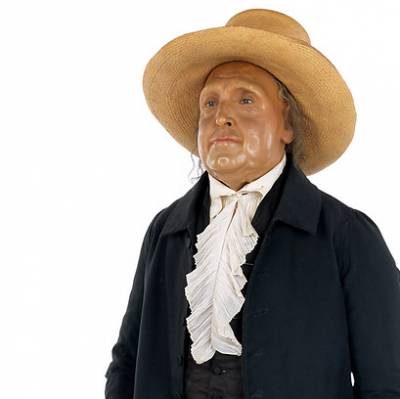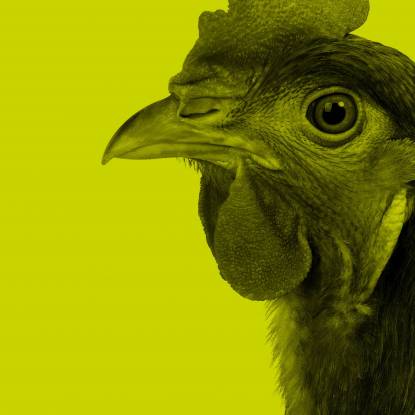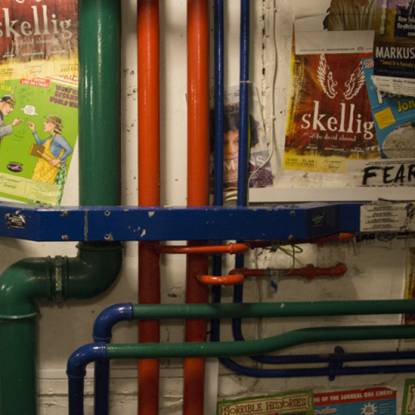Take me to:
at:
Let's go
Let's go
Jeremy Bentham on the move
20th December 2018
Jeremy Bentham
|
The auto-icon

Since 2012, UCL has been working on an extensive building and refurbishment programme - Transforming UCL - to develop the university's historic and iconic buildings, as well as creating new ground-breaking and sustainable spaces.
As part of this programme, Jeremy Bentham's famous auto-icon will be moved to a new location at the university. More information about his new home will be announced in 2019.
Share this:
Other articles like this one:

The Museum of Ordinary Animals
7th Sep 2017
[[{"fid":"5555","view_mode":"xl","fields":{"format":"xl","field_file_image_alt_text[und][0][value]":"Ordinary Animals","field_file_image_title_text[und][0][value]":"","field_caption_heading[und][0][title]":"","field_caption_heading[und][0][url]":"","field_caption[und][0][value]":"","field_caption[und][0][format]":"limited_html","field_float_left_right[und]":"none","field_file_image_decorative[und]":"0"},"type":"media","field_deltas":{"1":{"format":"xl","field_file_image_alt_text[und][0][value]":"Ordinary Animals","field_file_image_title_text[und][0][value]":"","field_caption_heading[und][0][title]":"","field_caption_heading[und][0][url]":"","field_caption[und][0][value]":"","field_caption[und][0][format]":"limited_html","field_float_left_right[und]":"none","field_file_image_decorative[und]":"0"}},"link_text":null,"attributes":{"height":"605","width":"1400","class":"media-element file-xl"}}]]Dogs, pigeons, cats, cows, chickens and mice - The Museum of Ordinary Animals tells the story of the boring beasts that have changed our world.We tend to take these animals for granted since they are such a normal part of our lives, but these often overlooked creatures have had a profound impact on humanity and the natural world. In this free exhibition, we’ll be investigating where they came from, and the extraordinary things we have learned from them.[[{"fid":"5543","view_mode":"xl","fields":{"format":"xl","field_file_image_alt_text[und][0][value]":"Dog nose","field_file_image_title_text[und][0][value]":"","field_caption_heading[und][0][title]":"","field_caption_heading[und][0][url]":"","field_caption[und][0][value]":"","field_caption[und][0][format]":"limited_html","field_float_left_right[und]":"none","field_file_image_decorative[und]":"0"},"type":"media","field_deltas":{"1":{"format":"xl","field_file_image_alt_text[und][0][value]":"Dog nose","field_file_image_title_text[und][0][value]":"","field_caption_heading[und][0][title]":"","field_caption_heading[und][0][url]":"","field_caption[und][0][value]":"","field_caption[und][0][format]":"limited_html","field_float_left_right[und]":"none","field_file_image_decorative[und]":"0"}},"link_text":null,"attributes":{"height":"640","width":"960","class":"media-element file-xl"}}]]The exhibition will include a wide range of objects exploring archaeology, art, zoology and the history of science, and will feature stories from cutting-edge research taking place at University College London that investigates 'Ordinary Animals' in the wider contexts of culture and the environment. Exhibits include a wall of 4000 mice skeletons hand-collected from islands across the world; a brand new (ethically sourced) taxidermy chicken; famous animal-based artworks from UCL Art Museum’s collection; and Egyptian cat mummies and what may be the world’s oldest veterinary text, on loan from The Petrie Museum of Egyptian Archaeology.[[{"fid":"5559","view_mode":"medium","fields":{"format":"medium","field_file_image_alt_text[und][0][value]":"Lucky cats","field_file_image_title_text[und][0][value]":"","field_caption_heading[und][0][title]":"","field_caption_heading[und][0][url]":"","field_caption[und][0][value]":"","field_caption[und][0][format]":"limited_html","field_float_left_right[und]":"left","field_file_image_decorative[und]":"0"},"type":"media","field_deltas":{"1":{"format":"medium","field_file_image_alt_text[und][0][value]":"Lucky cats","field_file_image_title_text[und][0][value]":"","field_caption_heading[und][0][title]":"","field_caption_heading[und][0][url]":"","field_caption[und][0][value]":"","field_caption[und][0][format]":"limited_html","field_float_left_right[und]":"left","field_file_image_decorative[und]":"0"}},"link_text":null,"attributes":{"height":"643","width":"1024","class":"media-element file-medium"}}]]“Ordinary Animals are everywhere, and the ways they interact with our lives are endless and varied”, said Jack Ashby, Manager of the Grant Museum, “We have invited them into our homes as pets; their role in our diets has changed us biologically; they are critical to modern medicine and they hold huge symbolic value in many cultures. This exhibition aims to shed light on the profound ways that these familiar creatures have changed both the human and natural worlds”. [[{"fid":"5539","view_mode":"xl","fields":{"format":"xl","field_file_image_alt_text[und][0][value]":"Pigeon skeleton","field_file_image_title_text[und][0][value]":"Pigeon skeleton","field_caption_heading[und][0][title]":"","field_caption_heading[und][0][url]":"","field_caption[und][0][value]":"%3Cp%3EPigeon%20Skeleton%26nbsp%3B%3Cb%3E%3Cfont%3E%3Cfont%3E%26copy%3B%26nbsp%3B%3C%2Ffont%3E%3C%2Ffont%3E%3C%2Fb%3EUCL%26nbsp%3B%3C%2Fp%3E","field_caption[und][0][format]":"limited_html","field_float_left_right[und]":"none","field_file_image_decorative[und]":"0"},"type":"media","field_deltas":{"1":{"format":"xl","field_file_image_alt_text[und][0][value]":"Pigeon skeleton","field_file_image_title_text[und][0][value]":"Pigeon skeleton","field_caption_heading[und][0][title]":"","field_caption_heading[und][0][url]":"","field_caption[und][0][value]":"%3Cp%3EPigeon%20Skeleton%26nbsp%3B%3Cb%3E%3Cfont%3E%3Cfont%3E%26copy%3B%26nbsp%3B%3C%2Ffont%3E%3C%2Ffont%3E%3C%2Fb%3EUCL%26nbsp%3B%3C%2Fp%3E","field_caption[und][0][format]":"limited_html","field_float_left_right[und]":"none","field_file_image_decorative[und]":"0"}},"link_text":null,"attributes":{"height":"683","width":"1024","class":"media-element file-xl"}}]]"Before humans, there were no 'Ordinary Animals'. We created them – either physically, through the process of domestication; or conceptually, through the ways we consider common wild species.” We hope you'll join us in giving these animals the attention they deserve! Check out more about the exhibition and linked events.[[{"fid":"5547","view_mode":"large","fields":{"format":"large","field_file_image_alt_text[und][0][value]":"mouse","field_file_image_title_text[und][0][value]":"","field_caption_heading[und][0][title]":"","field_caption_heading[und][0][url]":"","field_caption[und][0][value]":"","field_caption[und][0][format]":"limited_html","field_float_left_right[und]":"none","field_file_image_decorative[und]":"0"},"type":"media","field_deltas":{"1":{"format":"large","field_file_image_alt_text[und][0][value]":"mouse","field_file_image_title_text[und][0][value]":"","field_caption_heading[und][0][title]":"","field_caption_heading[und][0][url]":"","field_caption[und][0][value]":"","field_caption[und][0][format]":"limited_html","field_float_left_right[und]":"none","field_file_image_decorative[und]":"0"}},"link_text":null,"attributes":{"height":"467","width":"960","class":"media-element file-large"}}]]

Why is a Green Room so-called?
7th Aug 2017
At the Bloomsbury Theatre we’re having some major renovation work done before our grand reopening in Autumn 2018. And while it’s really exciting to see our facilities given the royal treatment – which you can read more about here and here - it also means we say a fond farewell to certain relics from our past. One such piece of history is these crazy poster collage from the walls of our green room. [[{"fid":"5175","view_mode":"xl","fields":{"format":"xl","field_file_image_alt_text[und][0][value]":"Bloomsbury Theatre green room","field_file_image_title_text[und][0][value]":"","field_caption_heading[und][0][title]":"","field_caption_heading[und][0][url]":"","field_caption[und][0][value]":"","field_caption[und][0][format]":"limited_html","field_float_left_right[und]":"none","field_file_image_decorative[und]":"0"},"type":"media","field_deltas":{"1":{"format":"xl","field_file_image_alt_text[und][0][value]":"Bloomsbury Theatre green room","field_file_image_title_text[und][0][value]":"","field_caption_heading[und][0][title]":"","field_caption_heading[und][0][url]":"","field_caption[und][0][value]":"","field_caption[und][0][format]":"limited_html","field_float_left_right[und]":"none","field_file_image_decorative[und]":"0"}},"link_text":null,"attributes":{"height":"3456","width":"5184","class":"media-element file-xl"}}]]Oh if these walls could speak! We can only speculate as the debauchery that’s taken place here, and frankly that’s probably not for a family audience so we’ll not dwell on it…It got us thinking though, why is a green room so-called? After a quick google search, we found there are loads of different theories including:Cockney rhyming slang for stage is “Greengage”Actors used to prepare for their performances in a room filled with plants. It was believed that the moisture was good for actors' voices.A red lamp is lit behind the scenes when recording or broadcasting is happening and a green lamp when the cameras are off or between takes. That last one sounds particularly unconvincing, especially because the earliest known use of the term ‘green room’ was in 1678 (before electric lamps), in Thomas Shadwell’s play A True Widow, which refers to "a green room behind the scenes". But it didn’t explain why it was a green room and if it was meant literally.[[{"fid":"5167","view_mode":"xl","fields":{"format":"xl","field_file_image_alt_text[und][0][value]":"Bloomsbury Theatre green room","field_file_image_title_text[und][0][value]":"","field_caption_heading[und][0][title]":"","field_caption_heading[und][0][url]":"","field_caption[und][0][value]":"","field_caption[und][0][format]":"limited_html","field_float_left_right[und]":"none","field_file_image_decorative[und]":"0"},"type":"media","field_deltas":{"1":{"format":"xl","field_file_image_alt_text[und][0][value]":"Bloomsbury Theatre green room","field_file_image_title_text[und][0][value]":"","field_caption_heading[und][0][title]":"","field_caption_heading[und][0][url]":"","field_caption[und][0][value]":"","field_caption[und][0][format]":"limited_html","field_float_left_right[und]":"none","field_file_image_decorative[und]":"0"}},"link_text":null,"attributes":{"height":"3333","width":"5000","class":"media-element file-xl"}}]][[{"fid":"5179","view_mode":"xl","fields":{"format":"xl","field_file_image_alt_text[und][0][value]":"Bloomsbury Theatre green room","field_file_image_title_text[und][0][value]":"","field_caption_heading[und][0][title]":"","field_caption_heading[und][0][url]":"","field_caption[und][0][value]":"","field_caption[und][0][format]":"limited_html","field_float_left_right[und]":"none","field_file_image_decorative[und]":"0"},"type":"media","field_deltas":{"1":{"format":"xl","field_file_image_alt_text[und][0][value]":"Bloomsbury Theatre green room","field_file_image_title_text[und][0][value]":"","field_caption_heading[und][0][title]":"","field_caption_heading[und][0][url]":"","field_caption[und][0][value]":"","field_caption[und][0][format]":"limited_html","field_float_left_right[und]":"none","field_file_image_decorative[und]":"0"}},"link_text":null,"attributes":{"height":"3456","width":"5184","class":"media-element file-xl"}}]]There didn’t seem to be a definitive answer anywhere we looked. So we decided to throw the question out there and see what answers we could get from some theatre friends of ours. The results are a mixed bag, but some of our favourites include: Actors backstage who were about to vomit were said to look ‘green’Green = youth. The green room was where understudies to major players/actors would wait for their chance to appear on stage.It was where a green sward (piece of fake grass) was stored to the side of the stage, used to signify an outdoor scene during the play.Some of these sound more credible, but we’re still no closer to knowing the truth! What do you think?We’ll be continuing the debate on Twitter, so send us your suggestions @UCL_Culture using the hashtag #whygreenroom #greenroom[[{"fid":"5183","view_mode":"xl","fields":{"format":"xl","field_file_image_alt_text[und][0][value]":"Bloomsbury Theatre green room","field_file_image_title_text[und][0][value]":"","field_caption_heading[und][0][title]":"","field_caption_heading[und][0][url]":"","field_caption[und][0][value]":"","field_caption[und][0][format]":"limited_html","field_float_left_right[und]":"none","field_file_image_decorative[und]":"0"},"type":"media","field_deltas":{"1":{"format":"xl","field_file_image_alt_text[und][0][value]":"Bloomsbury Theatre green room","field_file_image_title_text[und][0][value]":"","field_caption_heading[und][0][title]":"","field_caption_heading[und][0][url]":"","field_caption[und][0][value]":"","field_caption[und][0][format]":"limited_html","field_float_left_right[und]":"none","field_file_image_decorative[und]":"0"}},"link_text":null,"attributes":{"height":"3456","width":"5184","class":"media-element file-xl"}}]][[{"fid":"5191","view_mode":"xl","fields":{"format":"xl","field_file_image_alt_text[und][0][value]":"Bloomsbury Theatre green room","field_file_image_title_text[und][0][value]":"","field_caption_heading[und][0][title]":"","field_caption_heading[und][0][url]":"","field_caption[und][0][value]":"","field_caption[und][0][format]":"limited_html","field_float_left_right[und]":"none","field_file_image_decorative[und]":"0"},"type":"media","field_deltas":{"1":{"format":"xl","field_file_image_alt_text[und][0][value]":"Bloomsbury Theatre green room","field_file_image_title_text[und][0][value]":"","field_caption_heading[und][0][title]":"","field_caption_heading[und][0][url]":"","field_caption[und][0][value]":"","field_caption[und][0][format]":"limited_html","field_float_left_right[und]":"none","field_file_image_decorative[und]":"0"}},"link_text":null,"attributes":{"height":"3456","width":"5184","class":"media-element file-xl"}}]]
Subscribe to our newsletter
 Close
Close

